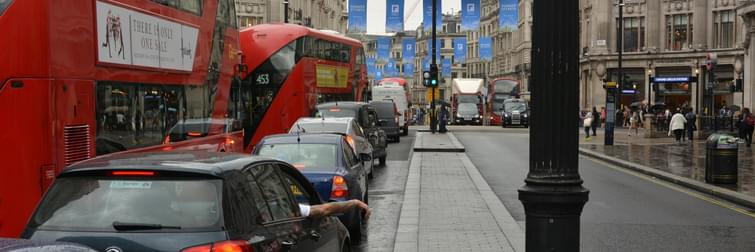
blog: Understanding and managing congestion in London
Wednesday 6th December 2017
Congestion in London costs the country an enormous amount of money each year. In 2016 INRIX estimated the cost of congestion in London to be £6.2 billion, while a CEBR study forecasts this value will increase to £9.3bn by 2030. Understanding why this has happened is central to better-managing congestion in the future.
To help TfL and GLA gain deeper insight into this critical issue, ITP was appointed to carry out detailed research into the causes of congestion in London. We were charged with making practically-focused recommendations to the Mayor in order to help inform the most-recent Draft Mayor’s Transport Strategy.
Despite falling car mode share, all available markers have demonstrated rising levels of traffic congestion over recent years. By combining data collected by TfL and other agencies, with opinions and viewpoints gathered through stakeholder interviews, our research team isolated some of the reasons for worsening congestion in London.
Changing patterns of road-use are at the heart of today's road traffic congestion patterns. An increasing number of people are shopping online, generating more deliveries and resulting in increasing LGV miles travelled. In addition, more people are using Private Hire Vehicles (PHVs), notably through apps such as Uber, GETT and myTaxi; which has also resulted in increased car mileages in London.
In a literal sense, implementing cycle superhighways across London has reduced the amount of road-space that was previously available for the circulation of motorised traffic. One short-term impact has been increased traffic congestion in some locations, where similar volumes of vehicles are now vying for a reduced amount of space – the ‘effective capacity’ of the road is reduced.
The most unfortunate casualty of this has been London’s bus network, which has recently begun to experience falling patronage for the first time in decades. This conflict is one that is relevant to transport agencies the world over – how do you choose between people using buses and people on bikes if you only have enough space to prioritise one mode?
Accommodating widespread uptake in cycling meets multiple aims; improving public health and reducing carbon and particulate emissions (with associated air quality benefits). But, bus travel is also one of London's most accessible and affordable urban mobility options for many people.
People who regularly use buses are often from poorer areas of London, compared with relatively affluent groups of people who represent primary Cycle Superhighway users. While cycling is sustainable and undoubtedly to be encouraged, whether it should be promoted above mass transit remains an open question.
In a UK context, London is a very specific case. As such, many of the challenges experienced there are not necessarily directly comparable with traffic congestion problems in other UK cities. However, the issues of mobility equality and fairness are increasingly common for transport authorities all over the UK. They need to be carefully considered in their own specific contexts; particularly as urban cycling movements gain momentum, private car ownership patterns change (falling slowly in London and major UK cities, but remaining stable or growing in most other places) and the bus remains largely un-loved. These often competing considerations will need to be carefully managed.
In the long-term though, the disruptive impacts of the cycle lanes experienced to-date are anticipated to reduce. Already, cycling in the capital has grown by more than 100% since the implementation of the superhighways.
Continuation of this trend long-term will reduce overall traffic volumes and help to cut levels of congestion. Thus, in the scope of the study (the next 5 years), we identified other measures to help manage congestion ‘at the margins’ in order to reduce its impact on the capital’s everyday operations.
TfL already operates programmes to manage most of the traffic congestion contributors that it is able to influence. In addition to these, ITP’s broader recommendations seek to reduce the total number of cars on the capital's roads by:
- Defining a hierarchy of priority between modes to inform all other policies - placing active and public transport modes above the use of private motorised vehicles.
- Adopting a London-wide, variable (e.g. by time/location/traffic levels), distance-based road user charging.
- Reviewing the present regulatory regime for Private Hire Vehicles - including a potential change to the law that would allow TfL the power to limit the number of vehicles licensed.
In total the report makes 22 recommendations for action by TfL, London Boroughs, Central Government and other stakeholders; with a range of intended outcomes.
As London continues to grow there are, inevitably, huge unknowns for the future of transport, but the optimistic and vision-driven approach taken by the Mayor is one which we support. Even so, there does need to be an ongoing and objective evaluation of London’s transport policy, in order to avoid inadvertent promotion of any agendas which have the potential to reduce accessibility for many by prioritising roadspace for a few.
Our report for TfL ‘Understanding and Managing Congestion’ can be downloaded here. If you would like more information about the project then please contact Jim Bradley, ITP's London-based Director, on: bradley@itpworld.net.
